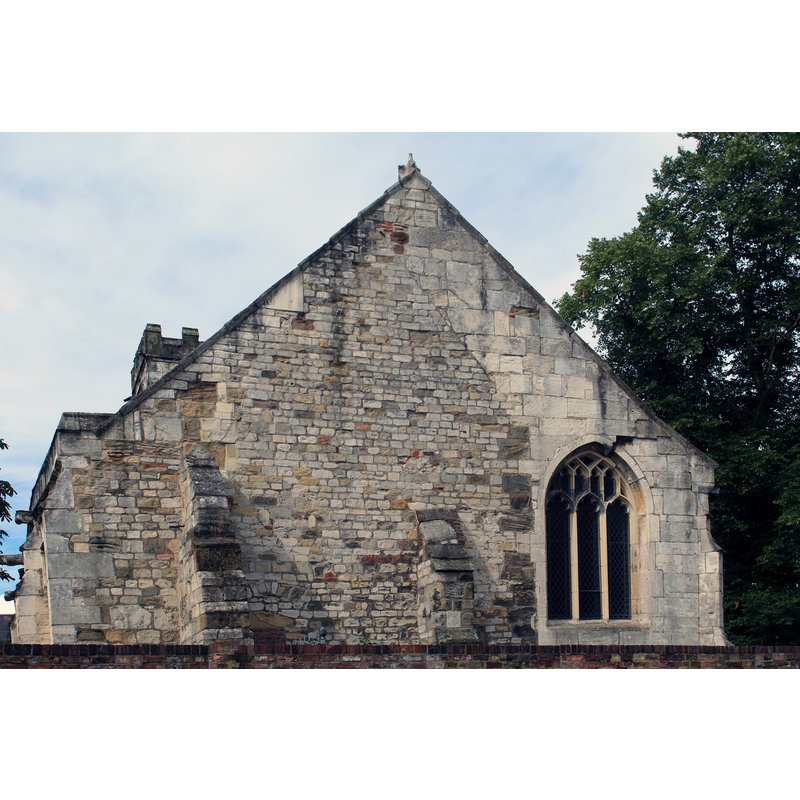York No. 10, Peaseholme Green / Eboracum / Eburacum / Eburākon / Eoforwic / Everwic / Jórvík

Image copyright © Chabe01, 2018
CC-BY-SA-4.0
Results: 2 records
view of church exterior - east end
Scene Description: "Parish Church, now offices of Church of St Michael-le-Belfrey, Minster Yard [...] Mid C15 incorporating late C11 east wall; C19 vestry and porch. Restored 1911-12" [source: Historic England [Listing NGR: SE6076652041]]
Copyright Statement: Image copyright © Chabe01, 2018
Image Source: digital photograph taken 28 July 2018 by Chabe01 [https://commons.wikimedia.org/wiki/File:Église_St_Cuthbert_York_6.jpg] [accessed 9 August 2019]
Copyright Instructions: CC-BY-SA-4.0
view of church exterior - southeast view
Scene Description: "Parish Church, now offices of Church of St Michael-le-Belfrey, Minster Yard [...] Mid C15 incorporating late C11 east wall; C19 vestry and porch. Restored 1911-12" [source: Historic England [Listing NGR: SE6076652041]]
Copyright Statement: Image copyright © Andrewrabbott, 2016
Image Source: digital photograph taken 8 August 2016 by andrewrabbott [https://commons.wikimedia.org/wiki/File:St_Cuthbert's_Church,_Peasholme_Green,_York.jpg] [accessed 9 August 2019]
Copyright Instructions: CC-BY-SA-4.0
INFORMATION
FontID: 14026YOR
Object Type: Baptismal Font1
Church/Chapel: Parish Church of St. Cuthbert [aka St Cuthbert's House of Prayer]
Church Patron Saints: St. Cuthbert [aka Cubertus]
Church Location: 4702 Peasholme Green, York, UK
Country Name: England
Location: North Yorkshire, Yorkshire and the Humber
Directions to Site: Located off (S) the 1036, in Peaseholm Green, NW of Layerthorpe, to the E of the historic city centre
Ecclesiastic Region: Diocese of York
Historical Region: Hundred of York
Font Location in Church: [cf. FontNotes]
Century and Period: 13th century, Early English
Church Notes: original church 11thC; present church ca. 1430; restored mid-19thC
Font Notes:
Click to view
There are twelve entries for York in the Domesday survey [https://opendomesday.org/place/SE6052/york/] [accessed 8 August 2019] eight of which mentions a church in it [cf. infra]. The entry for York churches in the Victoria County History (York, 1961) notes: "Eight churches are mentioned in Domesday: [...] three (St. Crux, St. Cuthbert, and Holy Trinity, Micklegate) may be certainly identified, and four (All Saints, Pavement, St. Andrew, St. Andrewgate, St. Martin, Coney Street, and St. Mary, Castlegate) with considerable probability; one is not named [...] Only of one church, and that an early one, is the foundation date certainly known: St. Olave's. [...] In 1087 William de Percy held the church of ST. CUTHBERT, Peaseholme Green, of Earl Hugh. [...] The church is not again mentioned until an institution is recorded in 1238 when the advowson belonged to Holy Trinity Priory [...] The church comprises [...] a nave with a tower at the west end; the porch and vestry are modern. Except for part of the east wall, which is 11th-century work, the building is of about 1500. [...] The church was restored between 1911 and 1912". Parker (1847) reports the presence of the then disused old font still in the church: "The font is good Early English, chalice shaped; it was long used as a water-butt, afterwards as a flower-pot, and is now stowed under the gallery stairs, and a modern slender one, in bad imitation of Perpendicular work, is used as a stand for a basin." Sheahan & Whellan (1857) note: "the font, which is octagonal, is new". Glynne (in Butler, 2007), who visited this church twice, probably in 1825 and 1846, mentions no font and dismissively describes the fitting of this church as "none of the tidiest". The RCHM (York, 1962- ) reports two fonts in this church; the one inside the church is octagonal, of painted stone, 19th-century; the one in the churchyard is a "shallow bowl with foliage carving on underside, very decayed stem, 18th-century." [NB: neither of these fonts match the description of the one noted in Parker [cf. supra], unless the one he noted is the one reported in the yard in the RCHM. The Yorkshire Historic Pages web site [http://www.northeastengland.talktalk.net/YorkStreets.htm#Peaseholme%20Green] [accessed 27 November 2008] notes: "St Cuthbert's Church, Peaseholme Green, was mentioned in the Domesday Book but there is known to have been an earlier Anglo-Saxon church. The church was saved from demolition by Martin Bowes, a Lord Mayor of London who had family connections with the parish." The entry for this church in Historic England [Listing NGR: SE6076652041] notes: "Parish Church, now offices of Church of St Michael-le-Belfrey, Minster Yard (qv). Mid C15 incorporating late C11 east wall; C19 vestry and porch. Restored 1911-12; converted c1980"; no font mentioned. [NB: we have no information on present whereabouts of the earlier font(s) of this church]
COORDINATES
Church Latitude & Longitude Decimal: 53.960747, -1.074953
Church Latitude & Longitude DMS: 53° 57′ 38.69″ N, 1° 4′ 29.83″ W
UTM: 30U 626297 5980870
MEDIUM AND MEASUREMENTS
Material: stone
Font Shape: chalice-shaped
Basin Interior Shape: round
Basin Exterior Shape: round
REFERENCES
Victoria County History [online], University of London, 1993-. Accessed: 2019-08-09 00:00:00. URL: https://www.british-history.ac.uk.
Glynne, Stephen Richard, The Yorkshire notes of Sir Stephen Glynne (1825-1874), Woodbridge: The Boydell Press; Yorkshire Archaeological Society, 2007
Great Britain. Royal Commission on Historical Monuments (England), An Inventory of the Historical Monuments in the city of York, London: H.M. Stationary Office, 1962-
Parker, I. H. [John Henry?], "Architectural notes of the churches and other ancient buildings in the city and neighbourhood of York", Memoirs illustrative of the history and antiques of the county and city of York […], London: J. Murray, 1847
Sheahan, James Joseph, History and topography of the city of York; the East Riding of Yorkshire and a portion of the West Riding […], Beverley: printed for the publishers by John Green, Market Place, 1857
!["Parish Church, now offices of Church of St Michael-le-Belfrey, Minster Yard [...] Mid C15 incorporating late C11 east wall; C19 vestry and porch. Restored 1911-12" [source: Historic England [Listing NGR: SE6076652041]]](/static-50478a99ec6f36a15d6234548c59f63da52304e5/compressed/1190809009_compressed.png)